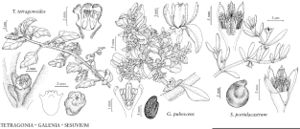Sesuvium
Syst. Nat. ed. 10, 2: 1052, 1058, 1371. 1759.
| Taxon | Illustrator ⠉ | |
|---|---|---|
 | Tetragonia tetragonioides Galenia pubescens Sesuvium portulacastrum | Barbara Alongi Barbara Alongi Barbara Alongi |
Herbs [shrubs], annual or perennial, succulent, usually papillate. Roots fibrous. Stems prostrate to erect, forming mats; rooting at nodes in some species. Leaves cauline, opposite, those of each pair equal; stipules absent; petiole bases clasping to ± connate, ± widened, margins usually scarious; blade usually flat, linear to spatulate or ovate, tapered, margins entire. Inflorescences axillary, flowers solitary or in cymes, sessile or pedicellate; bracts absent or 2. Flowers: hypanthium obconic; calyx lobes 5, reddish adaxially, usually hooded near tip; petals and petaloid staminodia absent; stamens [1–] 5–30, often connate proximally; pistil 2–5-carpellate; ovary half-inferior, 2–5-loculed; placentation axile; ovules to 60; styles 2–5, papillate; stigmas 2–5. Fruits capsules, ovoid to obconic, dehiscence circumscissile. Seeds to 60, black to brown, arillate, usually reniform, shiny or dull, smooth or rugose.
Distribution
Tropical, subtropical, and temperate North America, Mexico, West Indies, Central America, South America, Eurasia, Africa, Pacific Islands, Australia
Discussion
Species ca. 8 (4 in the flora).
Sesuvium crithmoides Welwitsch, a west African perennial with linear leaves and sessile flowers, has been reported from waste places along wharves in Georgia (J. K. Small 1933); it apparently is not naturalized in the flora.
Selected References
None.
Lower Taxa
Key
| 1 | Stamens 5; styles and locules 2-3; plants annual | > 2 |
| 1 | Stamens 30; styles and locules 5; plants perennial | > 3 |
| 2 | Seeds smooth, 1 mm | Sesuvium maritimum |
| 2 | Seeds rugose, 1.5 mm | Sesuvium trianthemoides |
| 3 | Pedicels 1-20 mm; stems rooting at nodes; seeds 1.2-1.5 mm | Sesuvium portulacastrum |
| 3 | Pedicels absent or to 2 mm; stems not rooting at nodes; seeds 0.8-1 mm | Sesuvium verrucosum |